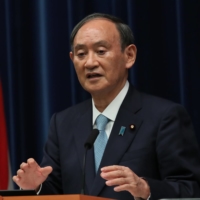The central government is leaning toward at least partially lifting the COVID-19 state of emergency covering 19 prefectures, including Tokyo, at the end of the month as scheduled, government and ruling party sources said Tuesday.
Prime Minister Yoshihide Suga is expected to make a final decision next Tuesday, the sources said.
Under the state of emergency, people are being urged to avoid going to crowded areas while restaurants are asked to close by 8 p.m. and not to serve alcohol. Attendance at large events such as concerts and sports games is limited to 5,000 or 50% of venue capacity, whichever number is smaller.
The Japanese capital became subject to the emergency declaration on July 12 to join Okinawa Prefecture, with the rest of the areas placed under the measure in August.
Suga, who is set to step down within days of the Liberal Democratic Party choosing its new leader on Sept. 29, is eager to ease restrictions for all the 19 areas including Osaka and Aichi prefectures before leaving office, the sources said.
Nationwide infections peaked at around 25,000 per day in August and have steadily declined since, with 2,224 new cases reported on Monday.
COVID-19 cases “are on a downward trend across the country and indicators in Tokyo have significantly improved,” Yasutoshi Nishimura, the minister in charge of Japan’s pandemic response, said at a news conference on Tuesday.
But hospitals continue to be strained by the large number of COVID-19 patients with severe symptoms, and there are concerns the three-day weekend through Monday may have triggered new outbreaks.
Some prefectures, such as Okinawa, where the situation has yet to significantly improve could get another extension of the state of emergency or may be downgraded to a quasi-state of emergency, which entails less severe restrictions, the sources said.
“We need to look at the trend for another week or so,” a person at the prime minister’s office said.
The state of emergency for Tokyo has been extended twice since July 12, with the capital remaining under the measure during the Olympics and Paralympics, which were held with a quarantine bubble at the athletes village and almost no spectators at venues.
In a time of both misinformation and too much information, quality journalism is more crucial than ever.
By subscribing, you can help us get the story right.
SUBSCRIBE NOW



